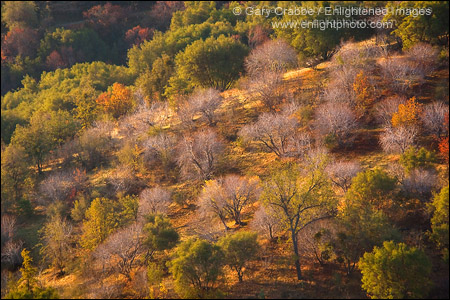Photo: Morning light on tree-covered hillside in the Sierra Foothills, Fresno County, California
Whenever I work with other photographers in a workshop setting, giving a lecture or presentation about improving their photography, I have a few general themes that I like to try and hammer into their heads. Those that have been field workshop clients know that I joke with them, “If you hear my voice in your head six months or two years from now, then I know I’ll have done my job.”
One of the first and most obvious is to “Photograph what you like.” Now that may sound like a no brainer, but it’s not. Otherwise, why would you see so many people showing photos with the caveat that they didn’t like this or that, be it a stray branch, bright patch of sky, etc.. I tell people to use their eyes like a zoom lens before taking the photo, to literally hone in on those elements of a photograph that they like.
In this image, I was coming back from Kings Canyon one morning, and was overlooking this really nice scene of the western Sierra foothills. While my brain and camera was set on wide-angle, I used my eyes like a telephoto lens to isolate parts of the larger scene in more detail. Then once I got my telephoto lens on the camera, I was able to focus on just that area or subject, and worked to include what I did like, while excluding what I didn’t like about the scene.
I mean seriously, if it’s something you don’t like, why would you want it in your photo? Right?




Great light. Great color. Great advice! Thanks Gary!
I like the warm colors too. I’ve started to try this, along with some other advice I read once that has to do with forcing yourself to find scenes that fit just one lens (sort of like what you’re talking about here).
I did that at a car show recently. My focus wasn’t the cars, but the people and the environment surrounding the nice cars. I actually used a telephoto zoom and tried to find shots that worked zoomed all the way out to compress the scenes and limit depth of field. That can be difficult for someone who enjoys landscapes and the wide-angle view of photojournalism, but it’s a worthwhile challenge.
Very good advice. Quite often I will have an emotional reaction to a scene, but if I rely on my right brain to take the photo, it is usaully disappointing. It is my left brain that is going to logically isolate the elements of the scene that are responsible for that emotional effect, as you indicate, and take the good photograph.
Gary:
So true!
An acquaintance whose father was a photographer recently said that he had given the advice, “photograph with your heart.” I like to say that the first thing (with some exceptions) is to look at the subject and think about why you like it and what you like about it. What drew you to look at it? What is it in this thing that engages you? Then begin to explore how to make photographs of it that possess or show that “thing” that means something to you.
For me it is often a matter of engaging both sides of my brain – neglecting the emotion or the logical can often make it much more difficult to create the photograph that you are aiming for.
(From the “it isn’t necessarily quite that simple” department: sometimes the logical part is so well practiced and engrained that it may seem to occur without conscious thought.)
Dan
absolutely… Good reminder to pay attention.